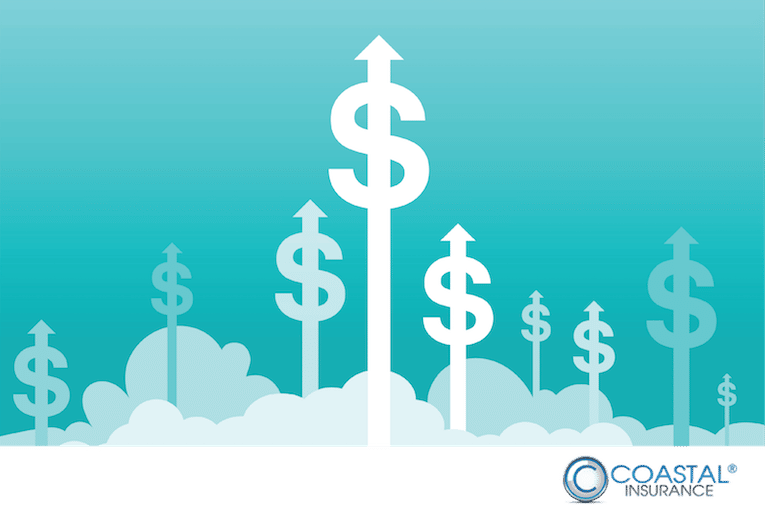 Everywhere you look these days, you’ll find costs rising. home insurance rates, just like the cost of homes themselves, are among those rising costs. But for many households, the rising costs of homeowners insurance rates have yet to impact them directly.
Everywhere you look these days, you’ll find costs rising. home insurance rates, just like the cost of homes themselves, are among those rising costs. But for many households, the rising costs of homeowners insurance rates have yet to impact them directly.
Along with many other types of insurance, home policy rates see a delayed effect because the policy’s premiums are fixed for the policy term. Any changes in premiums, where applicable, happen at renewal. This means that while you may have not yet seen an increase, it is likely coming when your policy comes up for renewal.
Insurers aren’t singling out homeowners in a certain area. Rates are going up for high-value homes everywhere.
It would be easy to point to inflation as the chief contributor to these upcoming higher rates, but the answer isn’t quite that simple; several additional factors play a role. This means insurance rate changes can exceed inflation rates in areas where other risks are changing as well.
To be informed is to be prepared. Here are some of the primary reasons for industry-wide increases as well as some context to illustrate how the various parts of your coverage fit together.
Increased Rebuilding Costs
While increased risk plays a significant role in high-value home insurance rates, rebuilding cost is the real crux of the matter, and high-value homes are in the spotlight due in part to the way many policies provide protection.
Most high-value home insurance policies often offer guaranteed replacement cost coverage, meaning the insurer will rebuild regardless of cost and insured limit if the policyholder selected this coverage. While this policy feature offers uncompromising protection, it also creates financial exposure for the insurer in a market where costs rise rapidly.
As an example, a $5 million home policy written two years ago (before the recent inflation spikes) would have a premium based on the rebuild cost at the time. To rebuild that same home today would probably cost 20% to 30% more due to increased labor costs, higher material costs, and pricing volatility due to lingering supply chain issues.
To illustrate the 20% increase in costs, a home with a rebuild cost of $5 million would cost an additional $1 million to rebuild today. This shortfall can extend to other areas of coverage as well, including contents coverage for household belongings and additional living expenses.
Expected increases span the entire industry and homes in all market segments, but the high-value home segment may see larger increases compared to mid-market homes.
Expected rate changes track increased rebuilding costs but also follow heightened natural risks closely, with some states seeing higher overall rates than others. In some cases, other policy changes may also apply at renewal, such as revised hail coverage in comparatively high-risk states like Texas.
Several states, including Hawaii, Washington, and Wisconsin, may see overall increases of under 10%. However, homeowners in other states such as Texas, Michigan, and Colorado might see overall increases of up to 15% or more.
Increasing Loss Values
Increases in the value of losses over time are normal and expected. Most of the past decade saw an inflation rate close to two percent according to BLS figures. But in a rising-inflation environment like we’ve seen since the second quarter of 2021, increases in the repair and replacement costs break the long-term trend line, forcing insurers to adjust.
The National Association of Insurance Commissioners (NAIC) data published by the Insurance Information Institute shows nationwide home insurance losses of about $39 billion in 2009. By 2019, the most recent year reported, that number had increased to over $68 billion, more than 74% higher.
Part of that increase reflects an increase in the number of homes, but only a small part. According to the Census Bureau, the total number of housing units increased by just 6.7% during a similar time period, 2010 to 2020. The remaining increase comes from other factors such as climate-related risk and higher rebuilding costs.
Insurance rates attempt to predict future costs, but they often must rely on data that will be out of date by the time the insurer pays a claim. Insurers bind coverage using cost estimates for labor and materials, although these cost measurements will likely change by the time the policyholder has a claim. So, in effect, insurance rates frequently run behind true insurance costs.
More Frequent Climate-Related Claims
Weather and climate-related risks take different forms in different parts of the country, resulting in unexpected cold-weather or hot-weather events, many of which cut a costly swath of damage through communities and entire regions.
Like other businesses, insurance is a numbers game. Insurers can provide policy-limit coverage far greater than the premiums they collect because loss risks generally follow a trend. Insurance companies use cost trends to predict future losses. But when these trends change, as can happen abruptly with weather, insurers must respond with rates that reflect the new trend in losses. Typically, this results in premium increases.
At its simplest level, insurance is the transfer of risk from an individual to a group. We all pay premiums, and the insurer pays for claims when an individual within the group has a covered loss. But when the costs of insuring the group increase, the premiums for individuals within that group have to increase as well. Weather and nature-related risks play a big role in this scenario.
By mid-September 2022, nearly 50,000 wildfires burned over 6.7 million acres across the US. By comparison, the 10-year average is just over 43,000 wildfires and under 6 million acres burned.
Just considering wildfires, the increased risk from this peril rose more than 13%. Unforeseen costs such as this example make it impossible for insurers to predict losses exactly, leading to future adjustments in premiums. In this instance, a rise in premiums represents an adjustment to account for true costs after those costs were realized.
Similar unexpected changes in claims costs arise in other weather-related scenarios as well, and it’s not just heat to blame. 2021’s cold snap that brought Texas to a frozen standstill with claims related to the tundra-like conditions resulted in nearly $6 billion in losses reported by 2022.
Compare Customized Quotes to Find The Best Rate
Just as rebuilding costs and regional risks can change over time, insurance needs can change as well. The experienced advisors at Coastal Insurance can help you design a high value home insurance package that considers your home’s value as well as your complete lifestyle. If you’re facing a rate increase, it may be best to compare new quotes.
High-value packages bring additional flexibility in policy structure, allowing you to personalize your protection and focus your coverage where you have the most financial risk. We’ll help you craft an insurance strategy targeted to your unique lifestyle, combined with the best rates possible.
Connect with our concierge team of luxury home insurance advisors to learn more about the best ways to protect your home and lifestyle. Our team of state licensed insurance advisors will help you compare rates from the finest insurance luxury home insurance companies like Chubb, Pure, AIG, Cincinnati, Openly and Vault
Resources
- The National Association of Insurance Commissioners (NAIC)
- Insurance Information Institute – Incurred Losses By State, Homeowners Insurance
- United States Census Bureau – 2020 Population and Housing State Data
- Center for Disaster Philanthropy – CDP
Related High Value Insurance Articles
About the Author
David W. Clausen is the CEO of Coastal Insurance Solutions. With over 20 years' experience and over 1 billion insured, David and Coastal Insurance Solutions are the recognized leaders in high net worth insurance. For the fifth consecutive year, David Clausen has been awarded Top Producer by Insurance Business America. David is a trusted high net worth insurance expert who’s published more than 200 articles. His articles & press releases have generated over 500K pageviews and has been featured on blogs such as Google News, Yahoo Finance, CNBC, Market Watch, Fox, The New York Times, etc. David founded Coastal Insurance Solutions in 2001 after earning a BBA from the State University of New York College at Oswego.
![IBA Top Retail Brokers 2024 Medal[88] IBA's Top Retail Broker 2023](https://coastalinsurancesolution.com/wp-content/uploads/2024/07/IBA-Top-Retail-Brokers-2024-Medal88.png)

![IBA Top Retail Brokers 2024 Medal[88] IBA's Top Retail Broker 2023](https://coastalinsurancesolution.com/wp-content/uploads/2024/07/IBA-Top-Retail-Brokers-2024-Medal88.png)






